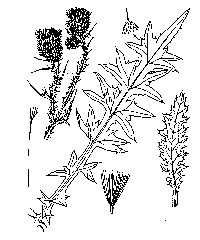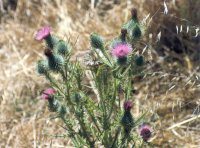|
Cirsium vulgare
|
|
|
|
Scientific name
|
Cirsium vulgare
|
|
Additional name information:
|
(Savi) Tenore
|
|
Common name
|
bull thistle, spear thistle
|
|
Synonymous scientific names
|
Cirsium lanceolatum, Carduus lanceolatus, Carduus vulgaris
|
|
Closely related California natives
|
20
|
|
Closely related California non-natives:
|
3
|
|
Listed
|
CalEPPC List B,CDFA nl
|
|
By:
|
John M. Randall
|
|
Distribution
|
|
HOW DO I RECOGNIZE IT?
Distinctive features:
|
A coarse biennial, bull thistle (Cirsium
vulgare) is distinguished from other thistles by the following combination of
characteristics. Leaf blades, especially those that are larger and deeply lobed,
are rough to the touch like medium sandpaper and dark green. Stems of bolted
plants appear winged because leaf blades continue along the petioles and several
inches down the stems. Flowerheads are one to two inches wide and one and a half
to two and a half inches high with deep purple flowers. The bristles on the
pappus (thistledown) are feathery. This characteristic distinguishes thistles in
the genus Cirsium from those in the genus Carduus, which have unbranched,
thread-like bristles.
|
|
Description:
|
| Asteraceae. Biennial thistle, 2-6 ft (60-200 cm) tall when mature. In the first year plants form a rosette that may grow to over 3 ft (1 m) in diameter. Rosette leaves oblanceolate to elliptic in outline and coarsely toothed on older plants. Plants usually bolt in the second year and may have a single stem, a branched stem, or many stems from a single root crown. Stems lightly covered with fine, white, cobwebby hairs and become woody with age. Leaves on stems of bolted plants alternate, up to 1 ft (30 cm) long, lanceolate and deeply lobed; green and rough with coarse hairs above and finer hairs on the underside, the midribs and veins extending beyond the leaf blades to form long, fierce spines. |
|
Leaf blades extend down petiole and along stem, forming long, prickly
wings. Plants may have one to many flowerheads (inflorescences or clusters of
flowers), each with an involucre composed of several overlapping series of
spine-tipped bracts (phyllaries). Bracts overlap, are lanceolate to linear in
outline, 1-1.5 in (3-4 cm) high, and tightly clasp the flowerhead when it is
immature, but begin to curl away after flowering begins and spread widely when
seeds are released. Flowers bisexual, purple (a white-flowered form exists but
is rare), 1-1.5 in (3-4 cm) long, producing abundant nectar. Flower has a
tubular corolla with 5 long, narrow lobes. Tube is about 1 in (23 mm) long with
a
|
|
WHERE WOULD I FIND IT?
|
Bull thistle is widespread in California
and is most common in coastal grasslands, along edges of fresh and brackish
marshes, and in meadows and mesic forest openings in the mountains below 7,000
feet (2,120 m). It is most troublesome in recently or repeatedly disturbed areas
such as pastures, overgrazed rangelands, recently burned forests and forest
clearcuts, and along roads, ditches, and fences. Even small-scale disturbances
such as gopher mounds promote bull thistle establishment and survival
(Klinkhamer and de Jong 1988, Randall 1991). It can also colonize areas in
relatively undisturbed grasslands, meadows, and forest
openings.
|
|
WHERE DID IT COME FROM AND HOW IS IT SPREAD?
|
Native to Europe, western Asia, and North
Africa, bull thistle is now naturalized and widespread throughout the United
States (including Hawaii and southeast Alaska) and southern Canada and on every
other continent except Antarctica (Grime et al. 1988). It probably was
introduced to eastern North America during colonial times as a contaminant in
seed and/or ballast (Moore and Frankton 1974) and to scattered locations in
western North America in the late 1800s or early 1900s (Jepson 1911). By 1925 it
had been reported in California from the San Francisco Bay Area, Central Valley,
Klamath region, North Coast, and the northern Sierra Nevada (Robbins
1940).
Bull thistle reproduces only by seed, and individual plants set
seed only once before dying. Large individuals may produce tens of thousands of
wind-dispersed seeds.
|
|
WHAT PROBLEMS DOES IT CAUSE?
|
Bull thistle invades a variety of wildland
habitats, where it competes with and displaces native species, including forage
species favored by native ungulates such as deer and elk. In addition to
outcompeting native plant species for water, nutrients, and space, the presence
of bull thistle in hay decreases feeding value and lowers market price (McDonald
1994). In pastures and irrigated rangeland it may interfere sufficiently with
livestock grazing so that live-weight gain is significantly reduced (Hartley
1983).
McDonald and Tappeiner (1986) noted that bull thistle often
dominates recently clearcut forest areas in the Sierra Nevada of California, and
experimental work in a replanted clearcut indicated that infestations limit
growth of ponderosa pine saplings (Randall and RejmÌÁnek 1993). Bull thistle also
colonizes and maintains high population densities for up to six years in
clearcuts in redwood and mixed evergreen forests in northwestern California
(Glusenkamp, pers. comm.).
|
|
HOW DOES IT GROW AND REPRODUCE?
|
Bull thistle is a rosette-forming biennial. Seedlings grow slowly until soil temperature rises in the spring. Absolute growth rates for thistle rosettes are slow for two months after sowing, even under ideal conditions. Only after two months do seedlings expand their leaves and accumulate dry weight rapidly. Seedlings quickly grow into rosettes, nearly stemless plants with leaves clustered radially at the soil surface or pressing against adjacent vegetation. They typically remain in the rosette phase through the first growing season and the following winter. Some studies indicate that rosettes must be exposed to cold temperatures before they will bolt and flower and may also require a minimum daily period of light following exposure to cold (Klinkhamer et al. 1987a, 1987b).
|
Most plants remain in the rosette stage for one year, then bolt, flower, and set seed in the second growing season, although some individuals may bolt and flower in the first year and others may not bolt until their third, fourth, or fifth year. Seeds are released in late summer or fall and may germinate after rains in fall or the following spring. Seed viability is high, often above 90 percent, and germination is stimulated by soil moisture.
|
(click on photos to view larger image)
|
Flowering may occur from early June until the first snowfall or
hard frost; in California there is a pronounced peak in July and early August.
Seeds ripen and are released from early July through October, occasionally later
along the coast. Studies indicate that most seeds fall within three feet of the
parent plant, but up to 10 percent may travel distances of more than ninety
feet, even on days with little wind (Klinkhamer et al. 1988, Randall unpubl.
data). A single flowerhead can produce from forty to over 250 seeds, and
individual plants may have anywhere from one to 475 flowerheads or more. Bull
thistle reproduces only by seed, and individual plants die after setting
seed.
åÊ
|
|
Physical control:
|
Mechanical methods: Bull thistle can be controlled by mowing or
hand cutting shortly before plants flower (Harris and Wilkinson 1984, Randall
1991). If cut too early in the season, plants will resprout and flower before
the first frost. The uneven flowering times may make more than one treatment
necessary. Gill (1938) reported that bull thistles that were cut while flowering
were not capable of producing and releasing viable seeds. Plants from Yosemite
Valley that were cut at the root crown a few days after their first flowers
appeared and then laid on the ground produced abundant viable seed (Randall
pers. observation). Thus it may be important to remove cut stems from the
area.
Less than 5 percent of adult thistles cut at the soil surface
resprouted, while over 80 percent of adult thistles in control plots survived
and flowered (Randall 1991). Mean height and number of inflorescences were lower
for plants that resprouted (twenty-five inches or 63 cm and 3.7 flowerheads)
than for adults in control plots (thirty-three inches or 85 cm and 15.8
flowerheads). Subsequent work (Randall unpubl. data) indicated that about 4
percent of the thistles cut two to four inches (5-10 cm) above the soil surface
a month before flowering will resprout.
Variations in seed production have more influence than
variations in adult mortality on population fluctuations of biennials (de Jong
and Klinkhamer 1988b). De Jong and Klinkhamer (1988a) found seed input limited
establishment of bull thistle seedlings on coastal dunes in the Netherlands.
Even if some plants resprout, manual control may reduce bull thistle populations
by limiting seed production. The distance seeds are dispersed is positively
correlated with the height at which they are released (Sheldon and Burrows
1973), so cutting may reduce the spread of seed even when plants resprout and
produce seed.
|
|
Biological control:
|
Two USDA approved insects, Urophora
stylata and Rhinocyllus conicus, have been released for bull
thistle control in California. Neither has been successful in controlling bull
thistle populations in California to date, but U. stylata shows some
promise in coastal sites where it was released in 1997 and 1998 (Villegas and
Coombs 1999). U. stylata is a gall-forming fruit fly (Tephritidae) with
a narrow host range that has been released at sites in Canada and the United
States (Harris and Wilkinson 1984, Julien 1987). Harris and Wilkinson (1984)
found that over 90 percent of the flowerheads examined in some British Columbia
populations had been attacked by the flies, and the number of larvae per
flowerhead increased with the percentage of flowerheads attacked. They
calculated that an infestation of this intensity reduced the populationÛªs seed
output by over 65 percent.
Rhinocyllus conicus is a weevil (Coleoptera,
Curculionidae) that attacks species of Cirsium, Carduus, and
Silybum. It has been used as a biocontrol agent for several species in
these genera. Studies indicate that there are local populations or strains with
strong preferences for particular host species (Zwolfer and Harris 1984). One
strain collected from bull thistle in France was released in 1984 in British
Columbia, where it bred well through 1986 (Julien 1987). A strain of R.
conicus introduced to southern California to control Carduus
pycnocephalus L. and Silybum marianum (L.) Gaertn. was rarely
found on bull thistle in the release area, although it destroyed an estimated 55
percent of its intended hostsÛª seeds (Goeden and Ricker 1986a). Unfortunately,
the weevils were occasionally found feeding on two native Cirsium
species (C. californicum Gray and C. proteanum T. Howell)
(Goeden and Ricker 1986b). R. conicus also attacks several other native
Cirsium species in the Rockies and the Great Plains and has been found
to limit populations of at least one of these native thistles (Louda et al.
1997, Louda 1998).
|
|
Chemical control:
|
Bull thistle is relatively easily
controlled with herbicides. Several Agricultural Extension bulletins recommend
2,4-D at 0.5 kg/ha; dicamba at 0.15 kg/ha; picloram (not registered in
California) at 1 kg/ha, and various tank mixes of these chemicals for control of
bull thistle (Fawcett and Nelson 1981, Harris and Wilkinson 1984). Timing of
herbicide application is important, with the exact date dependent upon life
cycle stage. Autumn or spring application is recommended to control rosettes
(Fawcett and Nelson 1981).
|




